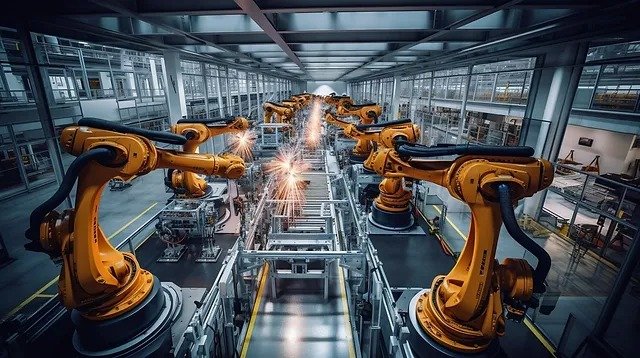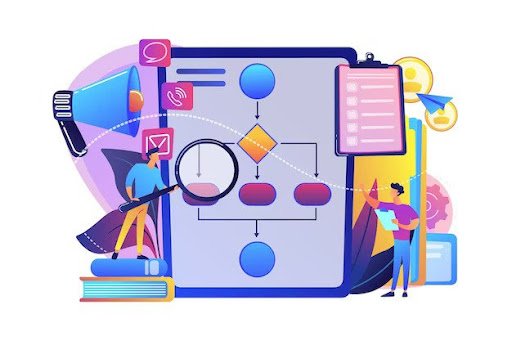12 Trending Manufacturing Website Design
The manufacturing industry’s value added is expected to reach US$15.36 trillion in 2024. It is estimated to expand at a compound annual growth rate (CAGR 2024–2028) of 3.56%. Along with this growth, an evolution is taking place in the manufacturing industry. Manufacturing businesses have adopted the digital revolution, despite being historically linked to tall smokestacks and assembly lines. Due to this change, the company needs a website that conveys both its expertise and its position at the forefront of innovation. Here, we examine the top website design trends that will influence how manufacturing will develop online in the future:
- A Story Told Through Bold Visuals:
Custom graphics that enhance a brand’s identity are becoming popular on manufacturing websites. Imagine witty artwork illustrating the effects of sustainable methods, or elaborate infographics displaying the production process. Consider 3D components that provide depth and interactivity to static, flat spaces to keep visitors interested.
- Interactive Storytelling:
Websites are evolving into interactive spaces where users can get into the details of your work. Consider incorporating features like:
- Interactive product tours: Allow potential clients to virtually explore your products, zoom in on details, and understand their functionalities.
- 360° factory tours: Offer immersive experiences that showcase the heart of your operations.
- Data visualization: Use compelling charts and infographics to depict your company’s commitment to sustainability, efficiency, or innovation.
- Prioritize User Experience (UX):
A user-friendly business website is necessary for all companies, but it’s especially important for manufacturing companies. Strive for a clean, intuitive interface. Utilize clear navigation, logical site structure, and easily scannable content. Embrace white space to avoid information overload, and make key information readily accessible.
- Mobile-First Design:
The modern user is constantly on the move. Make sure that using your website on all devices—especially mobile ones—is effortless. Employ responsive design principles that automatically adjust layouts for optimal viewing on smartphones and tablets.
- Content quality is priority:
There are more advantages to a well-designed website than merely aesthetic appeal. Put as much interesting and educational content on your website that appeals to your target audience as you can. Write blog posts that examine market trends and case studies that showcase completed projects
- SEO Optimization:
SEO remains a critical component of web design. For manufacturing companies, this means:
- Keyword Optimization: Using industry-specific keywords to improve search engine rankings.
- Technical SEO: Ensuring the website is technically sound with fast loading times, secure connections (HTTPS), and mobile-friendliness.
- Analytics: Leveraging analytics tools to track user behavior, measure performance, and make data-driven decisions.
7. Minimalistic and Clean Design
The online design industry is still dominated by minimalism, and manufacturing firms are starting to use this style more and more. Key characteristics include:
- White Space: Generous use of white space helps to highlight important content and improve readability.
- Simple Color Schemes: A limited color palette, often with one or two primary colors, keeps the design clean and cohesive.
- Clear Typography: Readable fonts with consistent sizing and spacing contribute to a professional and approachable feel.
8. Interactive and Personalized Experiences
Manufacturing companies can implement these features to enhance user engagement:
- Dynamic Content: Personalized content based on user behavior and preferences can improve relevance and engagement.
- Interactive Tools: Calculators, configurators, and other interactive tools allow users to customize products and see real-time updates.
- Chatbots and AI: Chatbots with AI capabilities can help customers instantly and assist them with the purchasing process.
9. Sustainability and Green Design
As sustainability becomes a global priority, many manufacturing companies are emphasizing their eco-friendly practices. This trend is reflected in website design through:
- Eco-Friendly Themes: Websites featuring green colors and nature-inspired visuals can convey a company’s commitment to sustainability.
- Sustainability Sections: Dedicated sections highlighting sustainable practices, certifications, and initiatives can build trust and attract environmentally-conscious customers.
- Energy-Efficient Design: Optimizing websites for lower energy consumption not only benefits the environment but also improves performance.
10. Content Management Systems (CMS) and Integrations
A robust CMS allows manufacturing companies to manage and update their website content efficiently. Modern CMS platforms offer:
- Flexibility: interfaces that are simple enough for non-technical employees to use and update content.
- Scalability: The ability to grow and adapt as the company’s needs evolve.
- Integrations: smooth interaction with additional company technologies including analytics programs, marketing automation platforms, and CRM systems.
11. Security and Data Privacy
With increasing concerns about data privacy and security, manufacturing companies must ensure their websites are secure:
- SSL Certificates: Secure Sockets Layer (SSL) certificates encrypt data transmitted between the user and the server.
- Data Protection: Putting in place robust data protection procedures to secure client information.
- Compliance: following applicable laws, such as the California Consumer Privacy Act (CCPA) and the General Data Protection Regulation (GDPR).
12. Integration of Advanced Technologies
Manufacturing companies can leverage these innovations to stay competitive:
- Artificial Intelligence (AI) and Machine Learning (ML): AI and ML can be used to enhance personalization, automate tasks, and improve decision-making.
- Augmented Reality (AR) and Virtual Reality (VR): Virtual tours and engaging product demonstrations can be offered with AR and VR.
- Internet of Things (IoT): Integrating IoT with web platforms can offer real-time data and insights, improving operational efficiency.
Conclusion
Manufacturing businesses need to adopt these website design trends in order to remain competitive and relevant as we approach 2024 and 2025. User engagement can be greatly increased by emphasizing mobile-first and responsive layouts, greater visual content, tailored experiences, and minimalistic and clean design. Additionally, emphasizing sustainability, UX/UI design, robust CMS platforms, SEO, security, and advanced technologies will ensure that websites of manufacturing companies not only meet the needs of their current customers but also attract and retain new ones.







